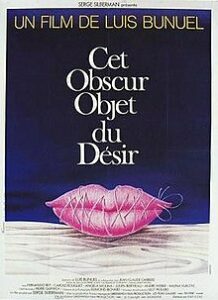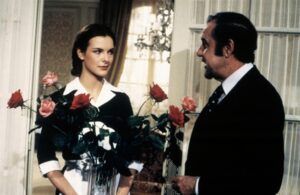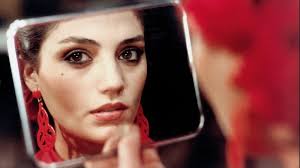“That Obscure Object of Desire” – the Bitter Taste of Love

Title: “That Obscure Object of Desire” (“Cet obscur objet du désir”)
Release Date: 1977
Director: Luis Buñuel
Cast: Fernando Rey, Carole Bouquet, Angela Molina, Julien Bertheau, Milena Vukotic
In his works Luis Buñuel mercilessly unmasks social roles and cultural conventions, showing how low motives may hide behind each of them. It is no different in the director’s latest film. “That Obscure Object of Desire” is about the motives that usually guide the actions of men and women, and how far we can go to get what we want.
“That Obscure Object of Desire” is a film which was made in 1977. It constitutes a kind of summary of Buñuel’s entire output. The Spanish director made this picture based on Louys’s novel “The Woman and the Puppet” from 1898, transferring its reality to modern times. The main character of the film is a very wealthy Frenchman, Matieu Faber (Fernando Rey), who loses his head for a young Spanish girl, Conchita. One day she shows up at his house as a new maid, but as soon as he tries to get close to her, she disappears without a trace.
“That Obscure Object of Desire” – Mathieu’s eternal unfulfillment
After a few months, Mathieu unexpectedly meets a woman in Geneva – Conchita returns the money stolen from him by a gang of thieves. Soon the protagonist begins to take a keen interest in the girl’s fate. He discovers that she lives in a shabby neighborhood with her poor mother. Counting on Conchita’s gratitude, Mathieu generously supports her financially. Every time, however, when the relationship is about to be consummated, the woman disappears. When Mathieu finally convinces her to move in with him, Conchita, who claims to be an immaculate virgin, is afraid to engage in a full sexual act. When Mathieu catches a young man in her room, he throws the girl out of the house and has her deported to Spain.

Nevertheless, he soon follows Conchita to Seville, where she again leads him by the nose. Mathieu discovers that Conchita is not only a traditional flamenco dancer, but also uses her money to reveal her charms to tourists. Conchita promises to give up her profession as a stripper if she gets a house. When he complies with the beautiful dancer’s demand, she bolts the door with a bar and makes him watch her make love to a young guitarist. However, she soon shows up at Mathieu’s house, claiming that the whole act was faked and that she kept her virtue. Mathieu brutally beats the girl and decides to return to Paris. When Conchita arrives at the train station, Mathieu pours a bucket of water on her and she returns the favor. Eventually, the characters stay together.
“That Obscure Object of Desire” – the two faces of a woman
“That Obscure Object of Desire” is a film in which Buñuel used a very interesting trick. He cast two actresses in the main female role, thanks to which he managed to show two contradictory natures of the same character. Carole Bouquet is the embodiment of innocence and feminine pride and strength at the same time. The sensual Angela Molina, on the other hand, embodies open eroticism, but also the ability to manipulate a man with sexual attributes. Buñuel’s peculiar idea can also be interpreted not so much as an observation on the duplicity of women, but on the specific perception of the fair sex by men. The narration is clearly conducted from Mathieu’s point of view – it is in his eyes that Conchita appears once as an angel and once as a self-interested manipulator.
“That Obscure Object of Desire” – a sadomasochistic game
In “That Obscure Object of Desire”, the relationship between a man and a woman becomes a game in which each of them wants to defeat the other at all costs. Conchita consciously uses Mathieu’s infatuation to demand more and more from him. Nevertheless, at the same time however she refuses to give herself to Mathieu for fear of losing her power over him. The rich Frenchman, on the other hand, takes sadomasochistic pleasure in being humiliated. The scenes of violence between Mathieu and Conchita clearly emphasize the peculiar perversity of this relationship.

Moreover, in “That Obscure Object of Desire”, each meeting of the lovers is accompanied by a terrorist attack. They both manage to survive until the final scene, when the entire shopping mall they are in is blown up. This leitmotif of Buñuel’s film is extremely ambiguous. One can see in it a metaphor for the destructive power of love. It seems to Mathieu that the feeling that leads to madness and total loss is alien to him, it concerns other, less reasonable people. Unexpectedly, he falls victim to his own passion. Planting a bomb under a wedding dress shop is also an allusion to the institution of marriage, which in the modern world is falling apart, but is also subject to unmasking.
“That Obscure Object of Desire” – Buñuel’s Surrealism
One of the most interesting elements of “That Obscure Object of Desire” are Buñuel’s surrealistic motifs. In the case of this work they come off exceptionally well, as they do not disturb the reception of the film; on the contrary, they make it more intriguing. One such element is, for example, the jute sack that Mathieu out of nowhere pulls out in several scenes or wears on his back. What does this surreal prop mean? A similar function is performed by the ambiguous scenes with the mousetrap, with Conchita’s things scattered in disarray, or the behavior of Mathieu’s butler.
“That Obscure Object of Desire” – a dark object of desire
But why did Buñuel call the title object of desire “obscure”? Contrary to what one might expect, the characters do not desire, for example, perverse sex. The darkness hides much deeper, in the innermost motives of the characters. In one of the film’s final scenes, Mathieu stares, with lust in his eyes, at a display where a woman is stitching bloody wedding underwear. The desire to strip Conchita of her virginity therefore has something impure about it. Mathieu wants to pay for something that cannot be bought, and he reduces virtue to the role of a fetish to satisfy his lust. The whole culture of elaborate conventions and conventions, on the other hand, masks the true motives for action and makes people into utilitarian objects.
A.Grabicz, „Kino, wehikuł magiczny. Przewodnik osiągnięć filmu fabularnego, 1974 – 1981”, Kraków 2009.
